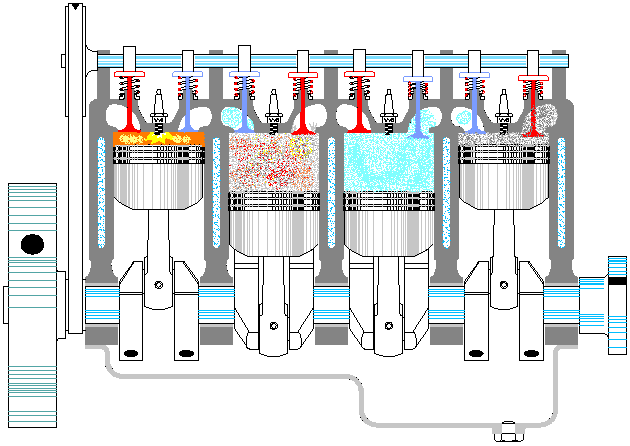Otto Cycle
The Otto cycle was a collaboration of ideas that was finally developed as a functioning four-stroke internal
combustion engine by a German engineer that went by the name Nicolaus Otto, occurring in the mid to late 1800s.
It is believed that the basic concept was around before Nicolaus Otto but he was the first to develop a functioning
engine. The idea behind the Otto cycle is simple, it uses a four stroke cycle to convert the energy available from the
combustion of a gas into rotational mechanical energy, or power. Below we will further discuss the mechanics of how
this is actually possible in real life and more about the theory of the Otto cycle.

http://users.telenet.be/cleanteam/index_bestanden/image997.gif
The picture above shows a four cylinder, four-stroke, Otto cycle engine. This is literally the exact engine in the majority of
compact cars today. It may look complicated from the picture above so let us break this engine down and simplify it.

http://image.stockcarracing.com/f/9445762/scrp_0801_02_z+twelve_budget_output+four_stroke_diagram.jpg
The four-strokes of Otto cycle are represented in the photo above. Note that this is one full cycle of one cyclinder,
this is not a representation of four cylinders like the previous photo. Now lets analyze this cycle:
1st Stroke: This is the intake stroke. During this stroke an intake valve is opened that lets in air and fuel, the two
ingredients necessary for combustion. This stroke is an adiabatic expansion process as no heat is added to the system.
2nd Stroke: This is the compression stroke. During this stroke the cylinder is sealed off from the outside atmosphere and the
air/fuel mixture is compressed so that it will easily and forcefully combust. This stroke is an adiabatic compression
process as no heat is added to the system.
3rd Stroke: This is the power or combustion stroke. This stroke is what makes this idea qualify as a heat engine, we are
directly turning the energy from heat, due to combustion, into rotational mechanical energy. Notice that both the valves
are closed during this process. We know that PV=nRT, so when heat is added at constant volume at the top of this stroke, in a
sealed cylinder, temperature increases, therefor pressure increases and causes a large force pushing the piston down the cylinder.
This force is also what gives us engine torque.
4th Stroke: This is the exhaust stroke. During this stroke the exhaust valve is opened. Excess heat and unwanted byproducts
of combustion are pushed out of the cylinder by the pistons now upward momentum. This is an important process because for the
whole cycle to repeat itself we need to clear the cylinder of CO2 and H2O, byproducts of combustion, two things that do not
easily combust.
Notice that the crankshaft, essentially the axis of rotation, is always rotating in one direction. This rotational motion carries
a lot of rotational kinetic energy that can be transferred to the wheels of a car for example, giving us power and the ability
to do work with that power. This power can be quantified and is represented in units of horsepower or kilowatts.
Know let us evaluate the equations for these forces:
Previous
...............
Home
...............
Next

